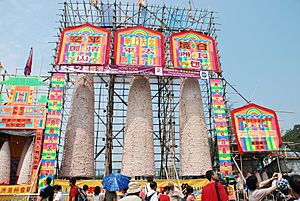Ping on bun
The Ping on bun is a special traditional food from Hong Kong. Its name means "peace bun" or "safety bun." People often eat these buns during a big festival.
Contents
History of the Ping on Bun
A long time ago, during the middle of the Qing Dynasty, a serious illness spread across the island of Cheung Chau. Many people got sick. To help, the villagers prayed to a god named Pak Tai. They believed he could help make the bad spirits go away. After the illness stopped, they built temples to thank Pak Tai. They saw him as their village's protector.
Over time, the yearly Cheung Chau Bun Festival became a tradition. During this festival, villagers would dress up like gods. They did this to help get rid of bad luck. The Ping on buns were used to build tall "bun towers." These towers were about 18 meters high and made of many buns. After prayers, the buns were given to the villagers. They were also offered to gods and spirits.
People in the village believed that eating a warm Ping on bun could help keep them healthy. They also thought that spreading powdered buns in the sea could help calm the ocean waves.
What's in a Ping on Bun?
Ping on buns first came from Hong Kong. The main things used to make them are low-protein flour, lotus seed paste, and sugar. They taste best when they are warm or at room temperature. You can also find them in special flavors, like red bean or green bean.
Cultural Impact
More than 48,000 visitors come to Cheung Chau for the bun festival each year.
Many people line up from early morning to get Ping on buns outside the Pak Tai Temple. One shop, Guo Jin Kee, sold over 10,000 Ping on buns in just one day! People sometimes had to wait half an hour to buy fresh buns.
Souvenirs related to the Ping on bun are also very popular. One seller, Kwong Koon Wan, made a lot of money selling things like bun-shaped cushions and fans. He expected to earn even more money from these fun items.
Challenges for Ping on Buns
Keeping Buns Safe
On May 24, 2015, a bakery in Cheung Chau was found to be selling Ping on buns with a special color. This color was not allowed to be used in food. The bakery had to throw away hundreds of buns. This caused them to lose a lot of money.
Wasting Food
Ping on buns are made with fresh ingredients. This means they can spoil easily. During the 2015 Cheung Chau Bun Festival, almost 10,000 buns went bad.
It rained a lot and the weather was hot. Because of this, the buns on the three bun towers became moldy. They even started to smell bad. Thousands of bun pieces were left on the ground after the festival. The Cheung Chau council had planned to give all the buns from the towers to the public. But since the buns spoiled, they had to buy new buns from other bakeries to give out instead.
A representative from a Cheung Chau bakery said that it costs more to make the buns now. Things like rent, ingredients, and packaging have become more expensive. So, the price of a Ping on bun went up from $6 to $7.


